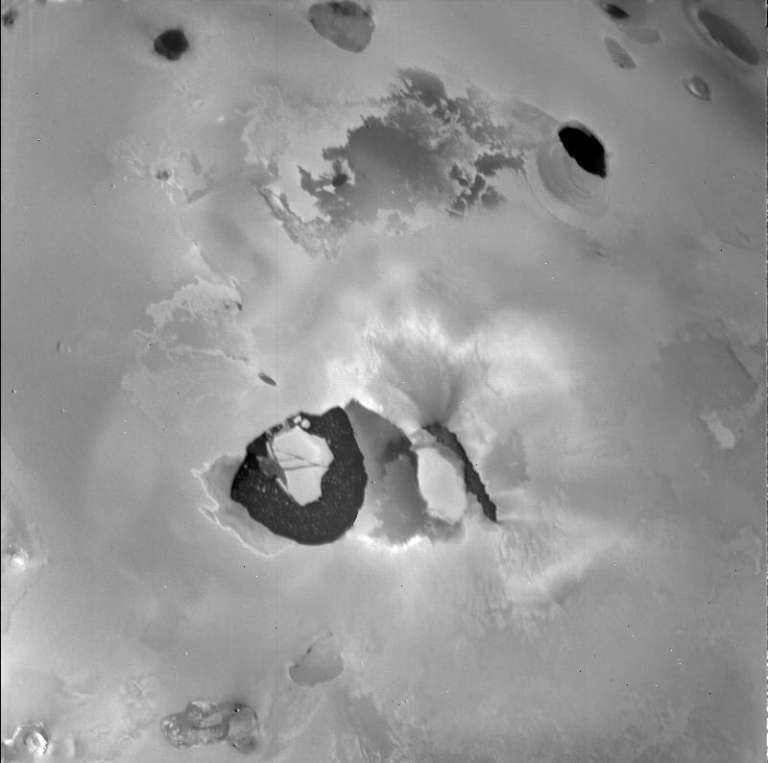Rosaly Lopes • Oct 07, 2010
Field trip to Piton
Planetary volcanologist Rosaly Lopes has just embarked on a field expedition to the active volcano Piton de la Fournaise, on Reunion Island, and is sending us updates for the blog. Thanks, Rosaly! --ESL
Monday, October 4
I'm glad to say that my talk was really well received. Being a keynote speaker, and the first talk of the meeting, meant I was under some pressure to give a good show! I reviewed calderas on Venus and Mars, including some results on dating of Martian caldera floors and sequence of collapse events from Mars Express data. The images are wonderful. I also talked about my favorite body, Io, and the great calderas there. There is much that we still don't understand about their formation and evolution and I hope to get some ideas here. There are more than 400 caldera-like features on Io, so they are a major type of feature on the surface. Some intriguing features present on several Ionian paterae are "islands" that are cold in thermal imaging and have not changed in morphology in the decades between the Voyager spacecraft (1979) and the last observations by the Galileo spacecraft (2001). You can see good examples of these "islands" on Loki and Tupan.

There are about 60 scientists at our workshop, only three from the US. We are a very international group, with people coming from about a dozen countries. My colleague from Hawaii, who flew via Paris, gets the prize for the longest journey to get here, but I'm not far behind. I'm the only planetary scientist present here and it's fun to be with real hard-core geologists and talk about calderas we can actually go to! On Wednesday we have a field trip to the volcano, which we were told by the local geologists is ready to erupt. Fingers crossed that we will get a good show. It will be frustrating if the eruption starts after we all go home, but such is the capricious nature of volcanoes!
Thursday, October 7
The workshop has moved to the field and time for blogging was cut short. We saw a lot of interesting geology in these last two days and had some exciting driving. Yesterday we went to one of the so-called cirques of the older Piton des Neiges volcano. Cirques are circular depressions that may have been caused by caldera collapse or landslides. To get to the Cilaos cirque, we took a road that climbed a caldera wall, then down on the inside. I've never seen so many tight switchbacks. The bus often had to stop and maneuver around them. Of course there was a sheer cliff on one side. It was exciting! There were also narrow tunnels carved into the rock and the bus barely fit through -- and it was a two way road! Somehow traffic on the opposite side just stopped and cars and buses took turns to go through. As the bus squeezed through the tunnels, I thought that if there was an emergency we could not open the doors. Or, if we managed to, only very skinny people could have gotten out. Glad I passed on the dessert.
The landscape is really beautiful, there are deep valleys cut into the volcano's flanks, and the vegetation is very lush on the older volcanic parts. Vegetation is not good for geologists, it is much better to have bare rock!
Today we went closer to the recently active part of the volcano and there was lots of bare rock, I loved being on a volcanic moonscape again. I love the sound of my boots crunching the lava and cinders. In the afternoon we stopped to visit the Piton de la Fournaise volcano observatory. They showed us the latest plots of seismic activity and inflation of the volcano. An eruption is really imminent, but it could be next week or later, and I only have one more day. That is the problem with active volcanoes, they never seem to erupt when you want them to.
Tomorrow we will walk around the potentially active caldera. I have to rush off from the field to my flight, so probably won't be able to report until Saturday. If there is an eruption, I'll let you know as soon as possible. I might even delay my flight...
Support our core enterprises
Your support powers our mission to explore worlds, find life, and defend Earth. You make all the difference when you make a gift. Give today!
Donate

 Explore Worlds
Explore Worlds Find Life
Find Life Defend Earth
Defend Earth


